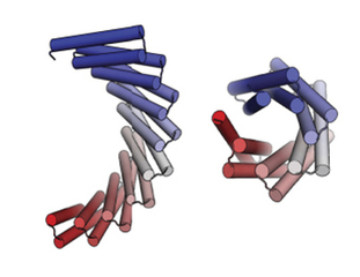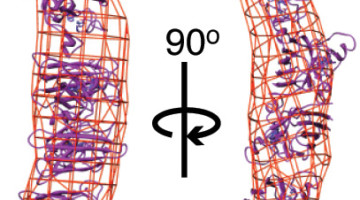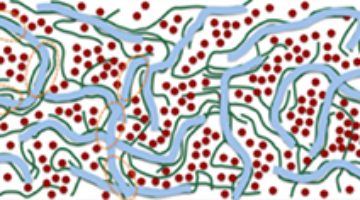Using an array of high-powered x-ray imaging techniques at the ALS, scientists have revealed for the first time the molecular steps that turn on bacteria’s pathogenic genes. The study could open up new avenues in the development of drugs to prevent or treat bacterial infection. Read more »![]()
![]()
Exploring the Repeat-Protein Universe
Researchers have published a landmark study that used both crystallography and SAXS to validate computationally designed structures of novel proteins with repeated motifs. The results show that the protein-folding universe is far larger than realized, opening up a wide array of new possibilities for biomolecular engineering. Read more »![]()
![]()
Superlattices Patterned by Polymers
Scientists have shown that self-assembled superlattices, made up of nanoparticles with polymer chains grafted onto their surfaces (“hairy nanoparticles,” or polymer “brushes”), can be tailored to exhibit desired characteristics for applications ranging from nano- to biotechnology. Read more »
Following the Morphology Formation In Situ in Printed Active Layers for Organic Solar Cells
Time-resolved scattering measurements reveal the complete solidification process inside the photoactive layer of an organic solar cell. With an industrial slot-die coater integrated into the beamline, aggregation and crystallization processes can be tracked to reveal the structure-function relationships in the final thin film. Read more »
2015 Director’s Awards
ALS staff took top honors in Lawrence Berkeley National Lab’s 2015 Director’s Awards for Exceptional Achievement and were recognized in a ceremony earlier this month. The ALS recipients comprised nearly half of this year’s awardees, receiving recognition in the scientific, early scientific career, and safety categories. The Director’s Awards honor individuals in both the scientific and operations divisions forRead More Read more »
SIBYLS Beamline Builds on Nobel Research
Often the full impact of a scientific discovery takes decades to realize, during which the research is developed further and adopted by other scientists. Such was the case for the work of biochemist Paul Modrich, one of three recipients of this year’s Nobel Prize in Chemistry. Berkeley Lab’s Advanced Light Source was a core resource Modrich used to build on his earlier work. Read more »
Protein Instability and Lou Gehrig’s Disease
A new study uses small-angle x-ray scattering as well as several advanced biophysical techniques to link protein instability to the progression of a lethal degenerative disease: amyotrophic lateral sclerosis (ALS), also known as Lou Gehrig’s disease. Read more »![]()
![]()
In Situ X-Ray Scattering Helps Optimize Printed Solar Cells
Printable plastic solar cells are a potential source of inexpensive renewable energy, but the transition from lab to factory results in decreased efficiency. Now, for the first time, a miniature solar-cell printer installed in a beamline allows researchers to use x-ray diffraction and scattering to figure out why. Read more »![]()
![]()
New ALS Technique Guides IBM in Next-Generation Semiconductor Development
A new measurement technique developed at the ALS is helping guide the semiconductor industry in next-generation nanopatterning techniques. NIST and IBM researchers collaborated on the technique, which allows scientists to evaluate the 3D buried features inside a film. The ALS is currently the only place in the world that has such capability.
The Molecular Ingenuity of a Unique Fish Scale
ALS research has shown how the scales of a freshwater fish found in the Amazon Basin can literally re-orient themselves in real time to resist force, in essence creating an adaptable body armor. Read more »![]()
![]()
- « Previous Page
- 1
- …
- 5
- 6
- 7
- 8
- Next Page »









